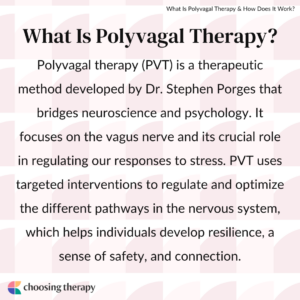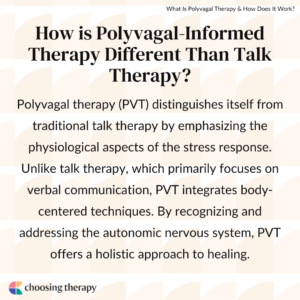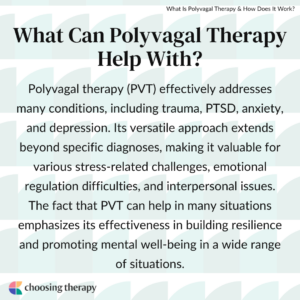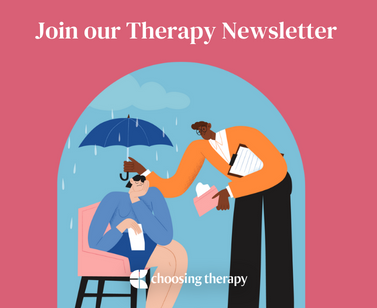Polyvagal therapy (PVT) is a therapeutic approach that helps individuals to understand better and manage their body’s response to stress and trauma. It focuses on the vagus nerve and the role it plays in regulating emotions and behaviors. PVT teaches self-regulation techniques to help individuals calm down, connect with others, and improve overall mental health and resilience.
Find the perfect therapist for you, with BetterHelp. If you don’t click with your first match, you can easily switch therapists. BetterHelp has over 20,000 licensed therapists who provide convenient and affordable online therapy. BetterHelp starts at $65 per week. Take a Free Online Assessment and get matched with the right therapist for you.
What Is Polyvagal Therapy?
Polyvagal therapy (PVT) is a therapeutic method developed by Dr. Stephen Porges that bridges neuroscience and psychology. It focuses on the vagus nerve and its crucial role in regulating our responses to stress. PVT uses targeted interventions to regulate and optimize the different pathways in the nervous system, which helps individuals develop resilience, a sense of safety, and connection.1
How is Polyvagal-Informed Therapy Different Than Talk Therapy?
Polyvagal-informed therapy distinguishes itself from traditional talk therapy by emphasizing the physiological aspects of the stress response. Unlike talk therapy, which primarily focuses on verbal communication, PVT integrates body-centered techniques. By recognizing and addressing the autonomic nervous system, PVT offers a holistic approach to healing. This unique blend of neuroscience and therapeutic practice sets Polyvagal-Informed Therapy apart, offering a more comprehensive and embodied healing path than conventional talk therapies.
What Can Polyvagal Therapy Help With?
Polyvagal therapy effectively addresses many conditions, including trauma, post-traumatic stress disorder (PTSD), anxiety, and depression. Its versatile approach extends beyond specific diagnoses, making it valuable for various stress-related challenges, emotional regulation difficulties, and interpersonal issues. The fact that PVT can help in many situations emphasizes its effectiveness in building resilience and promoting mental well-being in a wide range of situations.
Common conditions polyvagal therapy can treat include:
- Trauma
- PTSD
- Anxiety
- Depression
- Chronic Stress
- Panic Disorders
- Emotional dysregulation
- Interpersonal relationship issues
- Attachment issues
- Digestive issues
- Chronic pain
- Self-Esteem issues
- Sleep disorders
- Attention and focus issues
The Three Neural Pathways in Polyvagal Therapy
Polyvagal therapy revolves around three neural pathways closely linked to the autonomic nervous system. The ventral vagus pathway creates a sense of safety, promoting social engagement and emotional well-being. The sympathetic pathway activates the fight-or-flight response, mobilizing energy for action. Lastly, the dorsal vagus pathway initiates a shutdown response, a protective mechanism during extreme stress.2
Here are the three neural pathways that polyvagal therapy focuses on:
The Ventral Vagal Complex (Safe & Social)
The ventral vagal complex (VVC) is like the soothing part of our nervous system, making us feel safe and sociable. When it’s active, it helps us stay calm and encourages us to connect with others. In Polyvagal Therapy, the focus is on boosting VVC activation to help people confidently handle social situations, build meaningful relationships, and feel safe in their personal connections.3
The ventral vagal complex is responsible for characteristics like:
- Social behaviors
- Feelings of contentment
- Facial expressiveness
- Relaxation
- Enhanced communication skills
- Optimal digestion
- Cognitive flexibility
- Playfulness and creativity
- Empathy
- Resilience
- Improved immune function
The Sympathetic Nervous System (Mobilization)
The sympathetic nervous system (SNS) takes center stage in polyvagal theory during moments of perceived danger. When activated, it sets off the fight or flight response, mobilizing the body for action. In polyvagal therapy, understanding and regulating the SNS is crucial for managing stress and anxiety, ensuring a balanced response to challenges without unnecessary activation of the fight-or-flight mechanism.3
The sympathetic nervous system is involved in traits like:
- Heightened awareness
- Increased pulse rate
- Readiness for action
- Dilated pupils
- Rapid breathing
- Muscle tension
- Sweating
- Glucose release
- Slowing down digestion
- Blocking long-term functions
The Dorsal Vagal Complex (Shutdown)
The dorsal vagal complex (DVC) plays a pivotal role in polyvagal theory by initiating a freeze or shutdown response during overwhelming situations. When a person feels overwhelmed by a threat, the DVC (dorsal vagal complex) triggers a disengagement response. In Polyvagal Therapy, it’s important to recognize and deal with DVC activation, especially in individuals who tend to freeze when stressed. This can help them regain a feeling of safety and build resilience.4
The dorsal vagal complex is involved in signs like:
- Feeling disconnected
- Feeling stuck
- Emotional numbness
- Social withdrawal
- Reduced heart rate
- Digestive slowing
- Constricted blood vessels
- Feeling unable to move
- Decreased pain sensation
- Difficulty expressing emotions
Top Rated Online Therapy Services BetterHelp – Best Overall “BetterHelp is an online therapy platform that quickly connects you with a licensed counselor or therapist and earned 4 out of 5 stars.” Visit BetterHelp Talkspace - Best For Insurance Talkspace accepts many insurance plans including Optum, Cigna, and Aetna. Typical co-pay is $30, but often less. Visit Talkspace
How Polyvagal Therapy Works
Polyvagal therapy believes that our emotions are intricately linked to our physiological responses. In therapy, PVT therapists use exercises, such as breathwork and mindful awareness, to engage and regulate the three primary neural pathways of the autonomic nervous system. This helps people become more aware of their bodily sensations and emotional states and teaches them how to control their body’s response to stress.
Polyvagal Therapy Benefits
Polyvagal Therapy helps build resilience by strengthening the connection between the mind and body, enabling people to recover from difficulties. By using specific techniques, people learn to control their emotions better through emotional regulation skills so they can handle stress more effectively. It helps build resilience by strengthening the connection between the mind and body, enabling people to recover from difficulties. Many individuals say they feel better and experience relief from symptoms.
Techniques & Exercises in Polyvagal Therapy
Polyvagal Therapy incorporates many different techniques to regulate the autonomic nervous system. The techniques encourage self-regulation, foster resilience, and promote safety.
Common exercises used in polyvagal therapy include:
Grounding Methods
Grounding methods in polyvagal therapy involve techniques to bring individuals back to the present moment, connecting them with their immediate surroundings. This can include activities like focusing on the sensations of the breath, feeling the support of the ground beneath, or using sensory objects. Grounding helps regulate the nervous system by shifting attention away from distressing thoughts, promoting safety, and enhancing emotional stability.
Breathing Exercises
Breathing exercises in polyvagal therapy involve intentional control and awareness of the breath. Techniques like deep diaphragmatic breathing help regulate the autonomic nervous system, specifically calming the sympathetic response and activating the parasympathetic response. This promotes relaxation, reduces stress, and fosters emotional well-being by directly influencing the body’s physiological state.
Bodily Awareness Techniques
Bodily awareness techniques help to focus on cultivating mindfulness of physical sensations and bodily states. Individuals learn to tune into subtle cues such as muscle tension, heartbeat, and posture. By fostering a heightened awareness of the body, these techniques enable individuals to understand better and regulate their emotional responses, promoting a deeper mind-body connection and enhancing overall well-being.
Sound-Based Interventions
Sound-based interventions in polyvagal therapy involve using calming auditory stimuli, such as soothing music, humming, or gentle sounds. These interventions can have a regulating effect on the nervous system, promoting relaxation and reducing physiological arousal. By incorporating pleasant auditory experiences, individuals can enhance emotional regulation and create a sense of safety and comfort within the therapeutic process.
Mindful Movement Practices
Integrating mindful movement practices, such as yoga or tai chi, helps individuals release physical tension and promotes a mindful connection between body and mind. These practices contribute to emotional regulation and support overall well-being by engaging the body in a calming and intentional manner.
Self-Compassion Exercises
These exercises involve cultivating a kind and compassionate attitude toward oneself. By fostering self-compassion, individuals can counteract self-critical thoughts, reduce stress, and create a more supportive internal environment, contributing to emotional resilience and well-being.
Progressive Muscle Relaxation
Progressive muscle relaxation (PMR) involves systematically tensing and relaxing different muscle groups, promoting physical relaxation and reducing stress. This technique enhances bodily awareness and effectively releases tension, contributing to a more balanced nervous system response.
Visualizations & Guided Imagery
Guided imagery uses the power of imagination to guide individuals through calming mental images or scenarios. This technique helps redirect the mind away from stressors, promoting a positive shift in emotional states and fostering a sense of safety and calm.
Somatic Experiencing
Developed by Peter A. Levine, the somatic experiencing approach involves tracking and releasing trauma-related physical sensations. By focusing on bodily experiences, individuals can discharge trapped energy, alleviate trauma-related symptoms, and restore a sense of safety in the body.5
Biofeedback Training
Biofeedback training involves monitoring physiological responses, such as heart rate or skin conductance, and providing real-time feedback. By learning to control these responses, individuals gain greater awareness and control over their physiological reactions, contributing to improved emotional regulation and stress management.
Would you like to try therapy? Find a supportive and compassionate therapist! BetterHelp has over 20,000 licensed therapists who provide convenient and affordable online therapy. BetterHelp starts at $65 per week. Take a Free Online Assessment and get matched with the right therapist for you.
What to Look For in a Polyvagal Therapist
When choosing a polyvagal therapist, look for someone with a strong foundation in therapeutic skills, empathy, and a client-centered approach. It is important to check that they possess relevant certifications and ongoing education in polyvagal therapy. A qualified polyvagal therapist will integrate polyvagal theory seamlessly into their practice, demonstrating expertise in body-centered interventions and a nuanced understanding of the nervous system.
A good polyvagal therapist will:
- Be an expert in the practice of polyvagal therapy with education, experience, and certifications in the therapeutic modality
- Have clinical experience, especially in treating conditions relevant to polyvagal therapy, such as trauma, anxiety, and stress-related disorders.
- Utilize effective communication by understanding complex concepts and fostering a collaborative and transparent therapeutic relationship.
- Practice empathy by creating a safe and supportive space for clients to explore and heal.
- Engage in ongoing education and professional development, staying aware of the latest research and advancements.
- Be able to tailor interventions to the specific needs and preferences of the client, recognizing the importance of individualized care.
- Integrate insights from other therapeutic modalities, enriching the treatment approach and offering a comprehensive healing experience.
- Be culturally competent, respecting and understanding the nuances of each client’s cultural context.
Where to Find A Polyvagal Therapist
Finding a polyvagal therapist begins with exploring our online therapist directory. This platform will allow you to filter therapists based on location, specialties, and therapeutic modalities, including polyvagal therapy. Look for therapists who explicitly mention their expertise in polyvagal therapy, possess relevant certifications, and have experience treating your specific concerns, whether it’s trauma, anxiety, or stress.
Reading through therapists’ profiles and client reviews can also offer insights into their therapeutic approach and effectiveness. Don’t hesitate to ask potential therapists questions about their experience and how they integrate polyvagal therapy into their practice. This personalized search process ensures that you find a therapist who resonates with your needs and aligns with your therapeutic goals.
Betterhelp – Affordable, convenient, online therapy – Get 20% Off Your First Month
What to Expect at Your First Appointment
During your initial polyvagal therapy session, the therapist will likely focus on establishing a connection and understanding your unique needs. Expect an open discussion about your background, current challenges, and therapeutic goals. Unlike some traditional therapies, polyvagal therapy doesn’t necessarily involve diagnosing specific disorders but addresses underlying nervous system dysregulation.
Your therapist may introduce you to basic polyvagal concepts and conduct assessments to tailor interventions. You and your therapist will collaboratively establish treatment goals and discuss the frequency of future sessions, typically scheduling a series of appointments to facilitate ongoing progress.
For your first appointment, consider asking questions like:
- How does polyvagal therapy work, and how might it benefit me?
- What specific techniques or interventions do you often use in polyvagal therapy?
- How will our progress be assessed, and what can I expect regarding treatment planning?
- How frequently should I anticipate scheduling sessions?
- What is the expected duration of therapy, and how will we measure progress along the way?
These questions can help ensure that you clearly understand the therapeutic process and feel comfortable moving forward in your polyvagal therapy journey.
Integrating Polyvagal Therapy into Your Life
Integrating polyvagal therapy into your daily life involves applying the techniques you learned when on your own and, when possible, with the guidance of your therapist. Practice self-awareness by regularly checking in with your body’s sensations and emotional states. Incorporate grounding exercises during moments of stress and prioritize activities that activate your ventral vagal pathway, such as spending time with loved ones.
Collaborate with your therapist to customize techniques that align with your daily challenges, creating a personal toolkit for emotional well-being. While self-practice is beneficial, the support of a therapist ensures a deeper understanding and application of polyvagal therapy in your unique context.
In My Experience
Polyvagal therapy can be a powerful tool for individuals navigating stress, trauma, and emotional well-being complications. The therapy’s strength lies in its holistic approach, acknowledging the deep connection between mind and body. For clients presenting issues related to trauma or stress, I often emphasize the significance of integrating polyvagal concepts into their daily lives. Grounding techniques, mindful breathing, and fostering social connections become integral parts of their self-care repertoire.
My advice for clients considering polyvagal therapy is to approach it with openness and patience. It’s a journey of self-discovery and regulation, and progress may unfold gradually. The therapeutic relationship becomes a collaborative exploration, and clients are encouraged to communicate openly about their experiences and preferences. Seeking support through self-practice or with a therapist offers valuable insights into regulating the nervous system and building resilience.
To help our readers take the next step in their mental health journey, Choosing Therapy has partnered with leaders in mental health and wellness. Choosing Therapy is compensated for marketing by the companies included below. Online Therapy BetterHelp – Get support and guidance from a licensed therapist. BetterHelp has over 20,000 therapists who provide convenient and affordable online therapy. Take A Free Online Assessment and get matched with the right therapist for you. Free Assessment Online Psychiatry Hims / Hers If you’re living with anxiety or depression, finding the right medication match may make all the difference. Connect with a licensed healthcare provider in just 12 – 48 hours. Explore FDA-approved treatment options and get free shipping, if prescribed. No insurance required. Get Started Medication + Therapy Brightside Health – Together, medication and therapy can help you feel like yourself, faster. Brightside Health treatment plans start at $95 per month. United Healthcare, Anthem, Cigna, and Aetna accepted. Following a free online evaluation and receiving a prescription, you can get FDA approved medications delivered to your door. Free Assessment Starting Therapy Newsletter A free newsletter for those interested in learning about therapy and how to get the most benefits out of therapy. Get helpful tips and the latest information. Sign Up Choosing Therapy Directory You can search for therapists by specialty, experience, insurance, or price, and location. Find a therapist today.Additional Resources
What Is Exposure and Response Prevention Therapy? ERP therapy alters OCD’s pattern by addressing both obsessions and compulsions. In ERP, an individual is encouraged to confront the stimuli that trigger distress related to their obsessions while also resisting the urge to perform compulsions in an attempt to reduce their distress.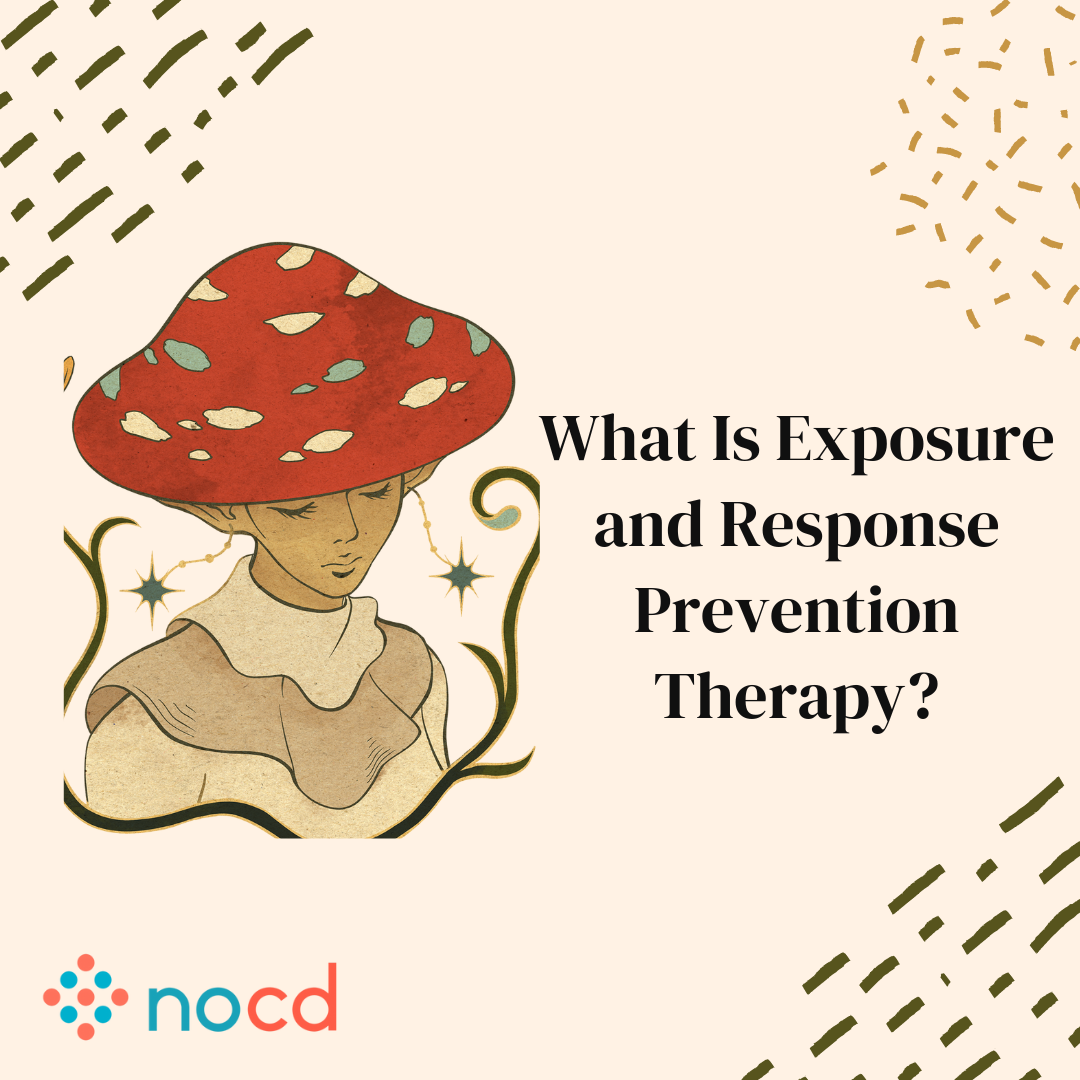
Why is ERP So Expensive? There are hundreds of OCD tests and “OCD quizzes” online. Some aim to help people self-diagnose; others turn obsessive-compulsive disorder into a joke. Either way, a vast majority of these are not helpful and probably create more problems than solutions.



